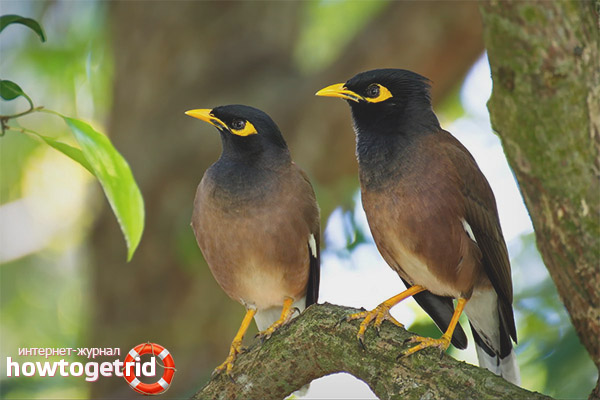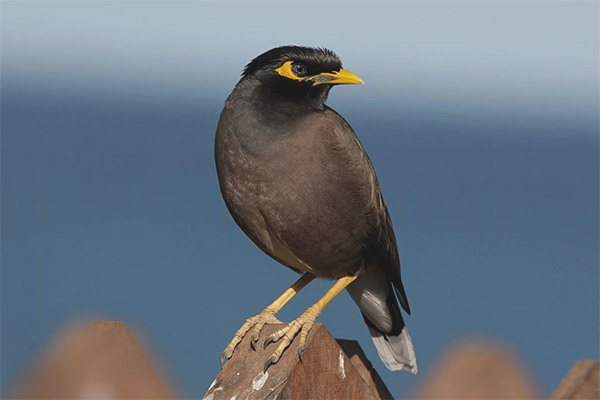The content of the article
Bird lane ordinary people sometimes called locust starling. It belongs to the starling family. In total, there are about 12 subspecies in nature.
A feature of the lane is that it is a good mockingbird. She memorizes various sounds and is able to repeat them. The bird also remembers human speech. The Latin name of the bird is Acridotheres tristis.
Appearance
If you look at the lane ordinary in flight, it looks like a medium-sized bird with a variegated color. If you look at the bird closer, the color looks darker.
These birds are somewhat larger in size than other starlings. The body length reaches about 27 cm. The bird weighs 125-135 g.
If you compare the lane with other starlings, then it has a more dense composition, its head is larger, and the tail is shorter. Representatives of this species are characterized by strong legs, as well as perfectly developed claws.
Looking for food on the ground, moving along it measuredly, with long strides. If the bird is in a hurry, it moves not by steps, but by jumps. Mayna, although it has rather short wings, flies very rapidly. But the flight can not be called easy. Young individuals are very similar in appearance to adult birds. But their plumage is somewhat paler.
Habitats
Representatives of this species live in Afghanistan, Iran, and Pakistan. They can also be seen on the territory of India, Ceylon, in some countries of Central Asia, where representatives of the species appeared only at the beginning of the last century. In a short time, the lanes settled there everywhere. Today, many of these birds live in Kazakhstan. The habitat of the common minera continues to expand further towards the north, as well as the north-west.
Today, representatives of this species can be seen in Australia and southern Africa, where they were introduced by people. This bird was also brought to many islands practically throughout the entire world ocean.
The lanes are resistant to external habitat conditions, so sometimes they can be seen even where birds usually do not live. There were cases when they were met on the territory of Russia and Israel. It is known that a small population of these birds settled in Moscow.
This is due to the fact that the birds were originally purchased for home keeping. Man was attracted by their ability to memorize and repeat words. But after a short time, many birds were simply released, as they made too much noise. The owners simply could not stand such a number of loud sounds made by the bird. And when the lanes were free, they adapted to life in nature, and created their colonies in place.
Food, lifestyle
In nature, these birds like to settle near the person. They can be met in gardens, kitchen gardens. Another favorite place for them is the edge of the forest.
The basis of the diet are various large insects. As a rule, it is orthoptera or beetles. These birds are sedentary, so they do not fly away from their nesting sites for the winter. Representatives of the species are quite able to survive the winter. People sometimes call the bird a locust starling for what the locust is their favorite delicacy in the summer. Parents feed their chicks also locusts. Legs and wings they do not eat, and tear off. The food for them is the head and the body of the locust.
Due to this, it can be noted that the lane brings a significant benefit to a person. When they catch locusts to feed their offspring, in one season, one pair of birds is able to kill about 150,000 individuals that are a threat to agriculture. But the benefits of the lane are not so straightforward. After all, they themselves cause considerable damage to the gardens. When cherries, apricots, and other juicy fruits ripen, the bird becomes a frequent visitor to the garden.
In the autumn and winter, when it becomes harder to find food, the lanes become visitors to landfills and barnyards. There they find the remains of grain and garbage, edible.
Breeding

In early spring, pairs form in the northern areas of their habitat in flocks. Mains sing during this period. Between males there is a war for good nesting sites.
The song of these birds has a very peculiar character. They emit characteristic croaking along with creaky whistles.
They nest in colonies consisting of a large number of individuals. Their nests are in hollows of various trees. Often they are high. Sometimes a place for arranging a nest for them becomes a mink on a cliff of a coast, a crack in a rock, or a crack in an abandoned building.
Why do people tame them
As already mentioned, lane is able to copy any sound, including words from human speech. In this they can safely compete with Jacquot parrots. They copy and caw, and chirping, and other sounds made by birds and beasts. You can tame them pretty quickly, and then keep in a cage.
Video: common lane (Acridotheres tristis)












To send